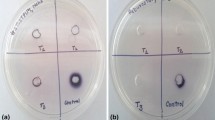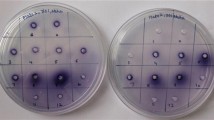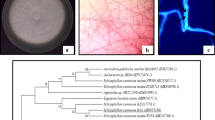Abstract
Xanthine oxidase is considered as a potential target for treatment of hyperuricemia. Hyperuricemia is predisposing factor for gout, chronic heart failure, atherosclerosis, tissue injury, and ischemia. To date, only two inhibitors of xanthine oxidase viz. allopurinol and febuxostat have been clinically approved for used as drugs. In the process of searching for new xanthine oxidase inhibitors, we screened culture filtrates of 42 endophytic fungi using in vitro qualitative and quantitative XO inhibitory assays. The qualitative assay exhibited potential XO inhibition by culture filtrates of four isolates viz. #1048 AMSTITYEL, #2CCSTITD, #6AMLWLS, and #96 CMSTITNEY. The XO inhibitory activity was present only in the chloroform extract of the culture filtrates. Chloroform extract of culture filtrate #1048 AMSTITYEL exhibited the highest inhibition of XO with an IC50 value of 0.61 μg ml−1 which was better than allopurinol exhibiting an IC50 of 0.937 μg ml−1 while febuxostat exhibited a much lower IC50 of 0.076 μg ml−1. Further, molecular phylogenetic tools and morphological studies were used to identify #1048 AMSTITYEL as Lasiodiplodia pseudotheobromae. This is the first report of an endophytic Lasiodiplodia pseudotheobromae from Aegle marmelos exhibiting potential XO Inhibitory activity.








Similar content being viewed by others
References
Neogi, T. (2011). New England Journal of Medicine, 364, 443–452.
Zhu, Y., Pandya, B. J., & Choi, H. K. (2011). Arthritis and Rheumatism, 63, 3136–3141.
Fukunari, A., Okamoto, K., Nishino, T., Eger, B. T., Pai, E. F., Kamezawa, M., et al. (2004). Journal of Pharmacology and Experimental Therapeutics, 311, 519–528.
Glantzounis, G. K., Tsimoyiannis, E. C., Kappas, A. M., & Galaris, D. A. (2005). Current Pharmaceutical Design, 11, 4145–4151.
Farquharson, C. A. J., Butler, R., Hill, A., Belch, J. J. F., & Struthers, A. D. (2002). Circulation, 106, 221–226.
Berry, C. E., & Hare, J. M. (2004). Journal of Physiology, 555, 589–606.
Chambers, D. E., Parks, D. A., Patterson, G., Roy, R., McCord, J. M., Yoshida, S., et al. (1985). Journal of Molecular and Cellular Cardiology, 17, 145–152.
Boueiz, A., Damarla, M., & Hassoun, P. M. (2008). American Journal of Physiology - Lung Cellular and Molecular Physiology, 294, 830–840.
Liebman, S. E., Taylor, J. G., & Bushinsky, D. A. (2007). Current Rheumatology Reports, 9, 251–257.
Arellano, F., & Sacristan, J. A. (1993). Annals of Pharmacotherapy, 27, 337–343.
Zhang, H. W., Song, Y. C., & Tan, R. X. (2006). Natural Product Reports, 23, 753–771.
Song, Y. C., Li, H., Ye, Y. H., Shan, C. Y., Yang, Y. M., & Tan, R. X. (2004). FEMS Microbiology Letters, 241, 67–72.
Pterini, O. (1986). In Fokkema & J. Van Den Heuvel (Eds.), Microbiology of phylosphere. Taxonomy of endophytic fungi of aerial plant tissues (pp. 175–187). Cambridge: Cambridge University press.
Rodrigues, K. F., Manfred, H., & Christa, W. (2000). Journal of Basic Microbiology, 40(4), 261–267.
Choudhary, M. I., Musharraf, S. G., Mukhmoor, T., Shaheen, F., Ali, S., & Rehman, A. U. (2004). Journal of Biosciences, 59, 324–327.
Agarwal, A., & Banerjee, U. C. (2009). The Open Biotechnology Journal, 3, 46–49.
Chang, W., Lee, Y., Lu, F., & Chiang, H. (1993). Anticancer Research, 13, 2165–2170.
Salkowski, E. (1898). Pflugers Archiv - European Journal of Physiology, 69, 268-306.
White, T. J., Bruns, T. D., Lee, S., & Taylor, J. W. (1990). Amplification and direct sequencing of fungal ribosomal RNA genes for phylogenies. In M. A. Innis, D. H. Gelfand, J. J. Sninsky, & T. White (Eds.), PCR protocols: A guide to methods and applications (pp. 135–322). San Diego: Academic.
Tamura, K., Peterson, D., Peterson, N., Stecher, G., Nei, M., & Kumar, S. (2011). Molecular Biology and Evolution, 28, 2731–2739.
Saitou, N., & Nei, M. (1987). Molecular Biology and Evolution, 4, 406–425.
Tamura, K., Nei, M., & Kumar, S. (2004). Proceedings of the National Academy of Sciences (USA), 101, 11030–11035.
Abdollahzadeh, J., Javadi, A., Goltapeh, E., Mohammadi, Zare, R., & Phillips, A. J. L. (2010). Persoonia, 25, 1–10.
Damn, U., Pedro, W. C., & Fourei, H. P. (2007). Mycologia, 5(99), 664–680.
Jothy, S. L., Zakaria, Z., & Sasidharan, S. (2011). Journal of Medicinal Plants Research, 5(10), 1941–1947.
Sahgal, G., Ramanathan, S., Sasidharan, S., Mordi, M. N., Ismail, S., & Mansoor, S. M. (2009). Molecules, 14, 4476–4485.
Nile, S. H., & Khobragade, C. N. (2011). Journal of Natural Products and Resources, 2, 52–58.
Wang, S. Y., Yang, C. W., Liao, J. W., Zhen, W. W., Chu, F. H., & Chang, S. T. (2008). Phytomedicine, 15, 940–945.
Shu, R. G., Wang, F. W., Yang, Y. M., Liu, Y. X., & Tan, R. X. (2004). Lipids, 39, 667–673.
Huang, W. Y., Cai, Y. Z., Kevin, D., Corke, H. H., & Sun, M. (2007). World Journal of Microbiology and Biotechnology, 23, 1253–1263.
Acknowledgment
The authors are thankful to the Head of the Department of Biotechnology, Thapar University, Patiala, Punjab for providing the necessary infrastructure to carry out the research work. The authors would like to acknowledge Shri Vinod Arora, Vice-President (Pharma Research) and Ms. Jyoti Srivastava, Ranbaxy Research laboratories, Gurgaon, India for providing febuxostat as a gift sample. This research received no specific grant from any funding agency in the public, commercial, or not-for-profit sectors.
Author information
Authors and Affiliations
Corresponding author
Rights and permissions
About this article
Cite this article
Kapoor, N., Saxena, S. Potential Xanthine Oxidase Inhibitory Activity of Endophytic Lasiodiplodia pseudotheobromae . Appl Biochem Biotechnol 173, 1360–1374 (2014). https://doi.org/10.1007/s12010-014-0927-x
Received:
Accepted:
Published:
Issue Date:
DOI: https://doi.org/10.1007/s12010-014-0927-x




